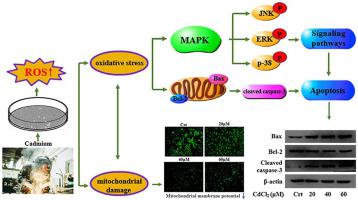Chemosphere ( IF 8.1 ) Pub Date : 2020-09-17 , DOI: 10.1016/j.chemosphere.2020.128346 Xiangyu Cao , Mingyang Fu , Ruochen Bi , Xiaomei Zheng , Baorong Fu , Siqi Tian , Chengying Liu , Qijiu Li , Jianli Liu

|
Cadmium, a heavy metal pollutant in industrial production, is found in air, water and soil, which is harmful to human health and can lead to diseases, such as asthma, lung cancer, and emphysema. In this study, the toxicity of cadmium on human bronchial epithelial cells (BEAS-2B) was investigated. Cell viability, mitochondrial membrane potential, reactive oxygen species (ROS) level, apoptosis and related signaling pathways were detected with MTT assay, Rhodamine staining, DCFH-DA staining, Hoechst33258 staining and Western blot methods. The results showed that the cell viability decreased, the mitochondrial membrane potential declined, ROS was accumulated and apoptotic rate raised in BEAS-2B cells. Meanwhile, the expression of B-cell lymphoma-2 (Bcl-2) downregulated, while the expression of Bcl-2-associated X protein (Bax) and the cleaved caspase-3 was upregulated, which indicated mitochondria-mediated intrinsic apoptosis pathway was activated. Furthermore, the phosphorylation of JNK, ERK and p38 was enhanced respectively, which manifested that MAPK signaling pathways were activated. Therefore, it can be concluded that cadmium could increase intracellular ROS, result in cellular oxidative stress, activate JNK, ERK and p38 MAPK pathways and ultimately result in apoptosis of BEAS-2B cells by activating mitochondria-mediated intrinsic apoptosis pathway. This study provided useful information to elucidate the toxicity on cadmium and revealed the possible mechanism for the occurrence of lung disease induced by cadmium.
中文翻译:

镉通过MAPK信号通路诱导BEAS-2B细胞凋亡和线粒体损伤
镉是工业生产中的重金属污染物,存在于空气,水和土壤中,对人体健康有害,可导致哮喘,肺癌和肺气肿等疾病。在这项研究中,研究了镉对人支气管上皮细胞(BEAS-2B)的毒性。MTT法,若丹明染色,DCFH-DA染色,Hoechst33258染色和Western印迹法检测细胞活力,线粒体膜电位,活性氧(ROS)水平,细胞凋亡及相关信号通路。结果表明,BEAS-2B细胞活力下降,线粒体膜电位下降,ROS积累,凋亡率升高。同时,B细胞淋巴瘤2(Bcl-2)的表达下调,Bcl-2相关X蛋白(Bax)和裂解的caspase-3的表达上调,表明线粒体介导的内在凋亡途径被激活。此外,JNK,ERK和p38的磷酸化分别增强,表明MAPK信号通路被激活。因此,可以得出结论,镉可以通过激活线粒体介导的内在凋亡途径,增加细胞内ROS,导致细胞氧化应激,激活JNK,ERK和p38 MAPK途径,并最终导致BEAS-2B细胞凋亡。这项研究提供了有用的信息,以阐明对镉的毒性,并揭示了镉诱发肺部疾病发生的可能机制。此外,JNK,ERK和p38的磷酸化分别增强,表明MAPK信号通路被激活。因此,可以得出结论,镉可以通过激活线粒体介导的内在凋亡途径,增加细胞内ROS,导致细胞氧化应激,激活JNK,ERK和p38 MAPK途径,并最终导致BEAS-2B细胞凋亡。这项研究提供了有用的信息,以阐明对镉的毒性,并揭示了镉诱发肺部疾病发生的可能机制。此外,JNK,ERK和p38的磷酸化分别增强,表明MAPK信号通路被激活。因此,可以得出结论,镉可以通过激活线粒体介导的内在凋亡途径,增加细胞内ROS,导致细胞氧化应激,激活JNK,ERK和p38 MAPK途径,并最终导致BEAS-2B细胞凋亡。这项研究提供了有用的信息,以阐明对镉的毒性,并揭示了镉诱发肺部疾病发生的可能机制。ERK和p38 MAPK途径并通过激活线粒体介导的内在凋亡途径最终导致BEAS-2B细胞凋亡。这项研究提供了有用的信息,以阐明对镉的毒性,并揭示了镉诱发的肺部疾病发生的可能机制。ERK和p38 MAPK途径并通过激活线粒体介导的内在凋亡途径最终导致BEAS-2B细胞凋亡。这项研究提供了有用的信息,以阐明对镉的毒性,并揭示了镉诱发肺部疾病发生的可能机制。











































 京公网安备 11010802027423号
京公网安备 11010802027423号